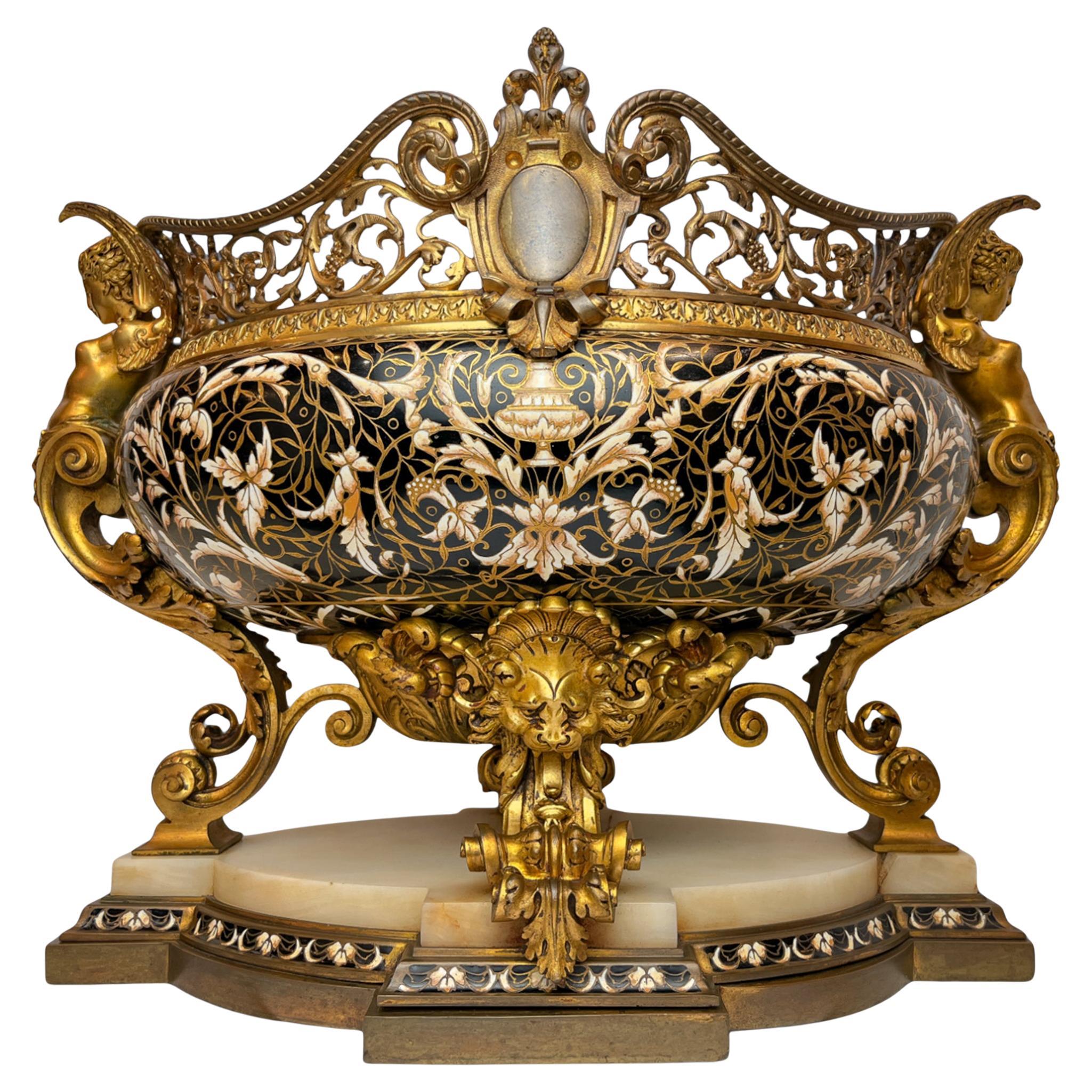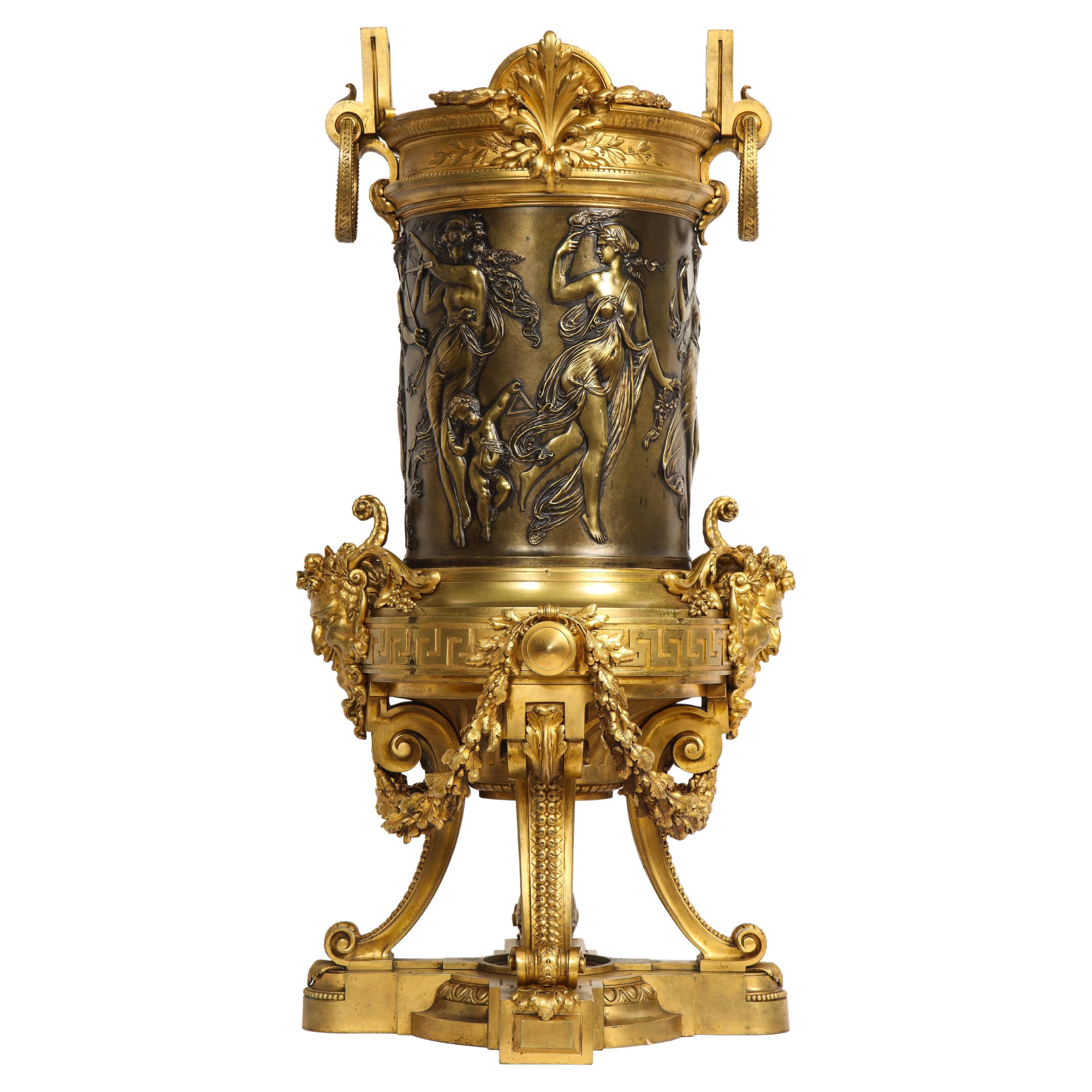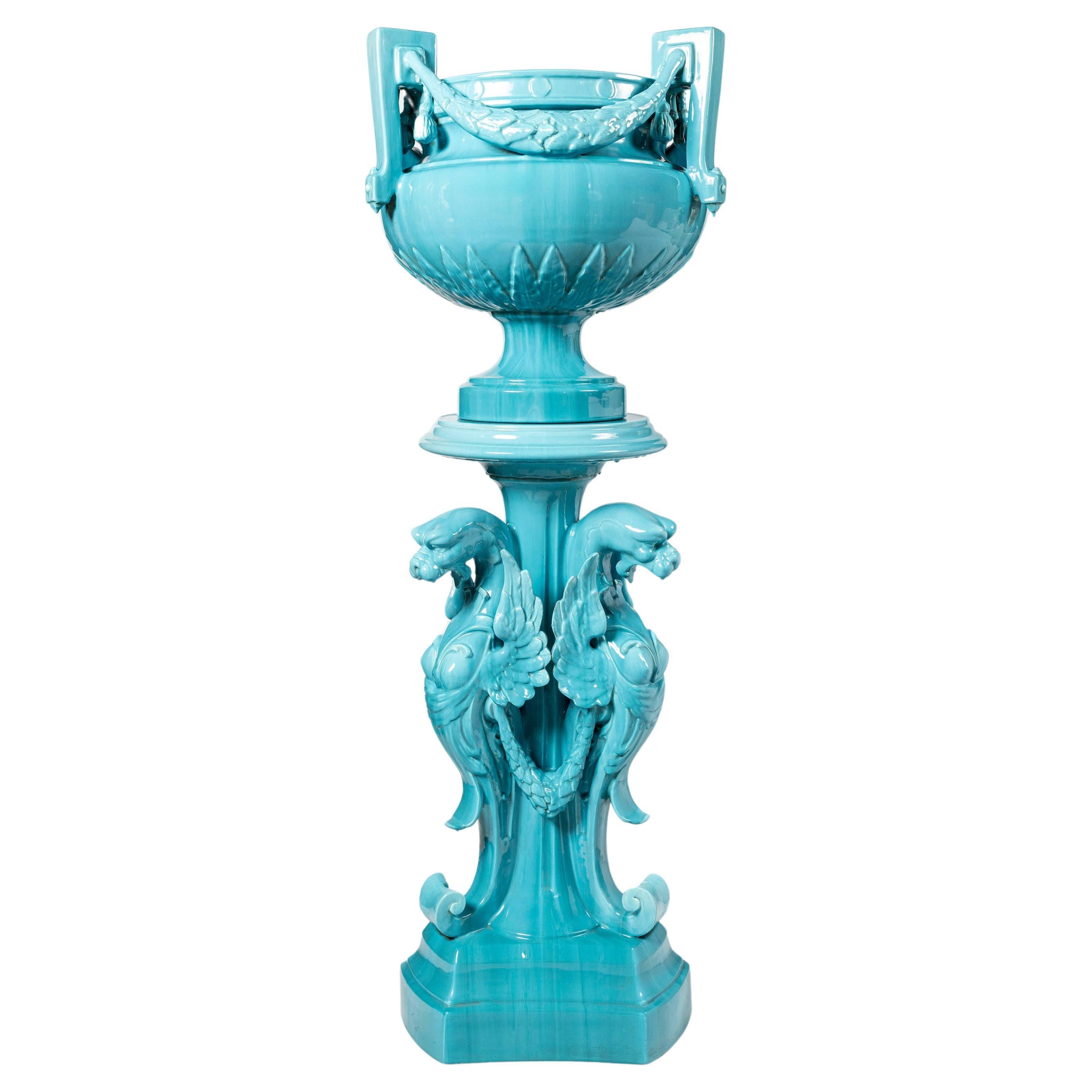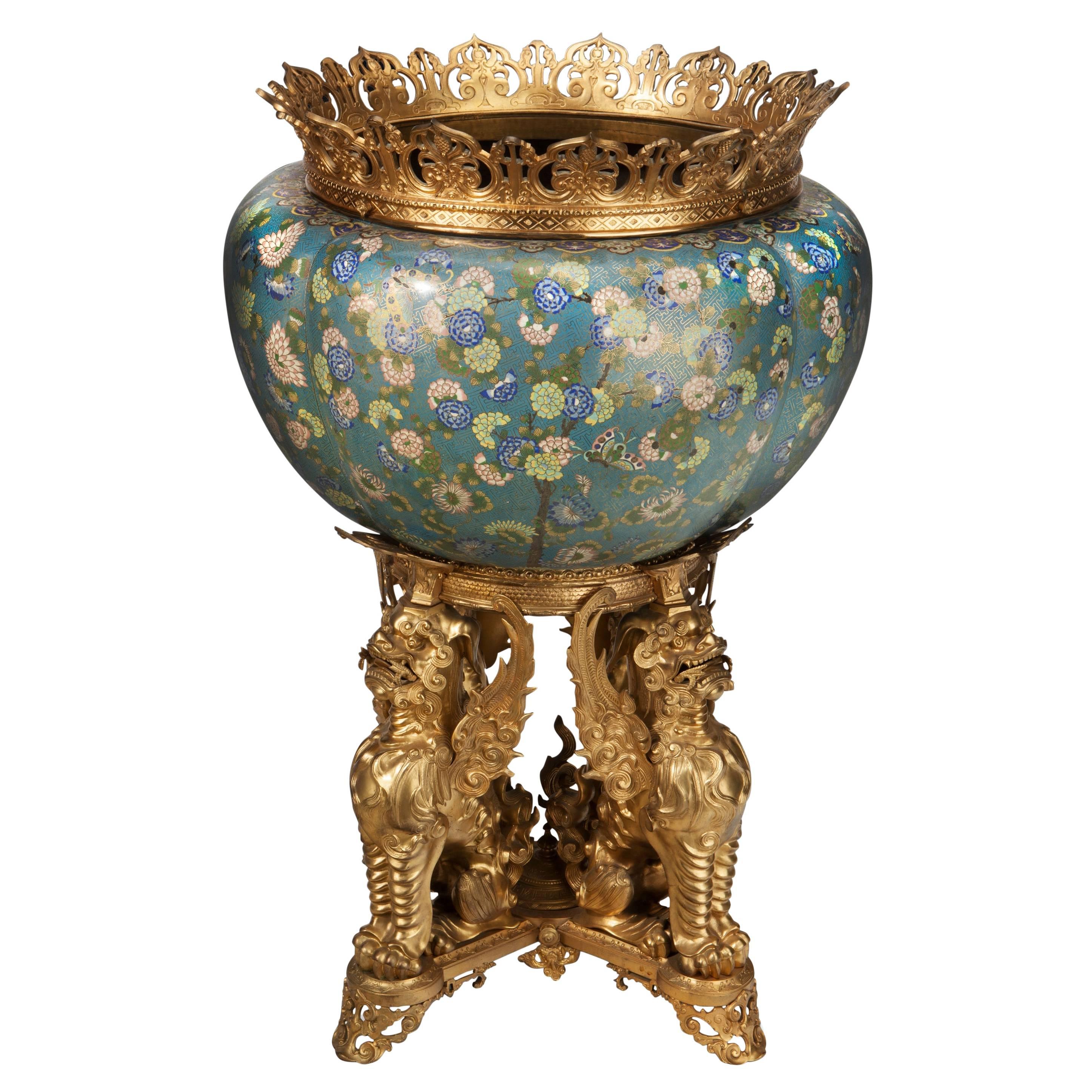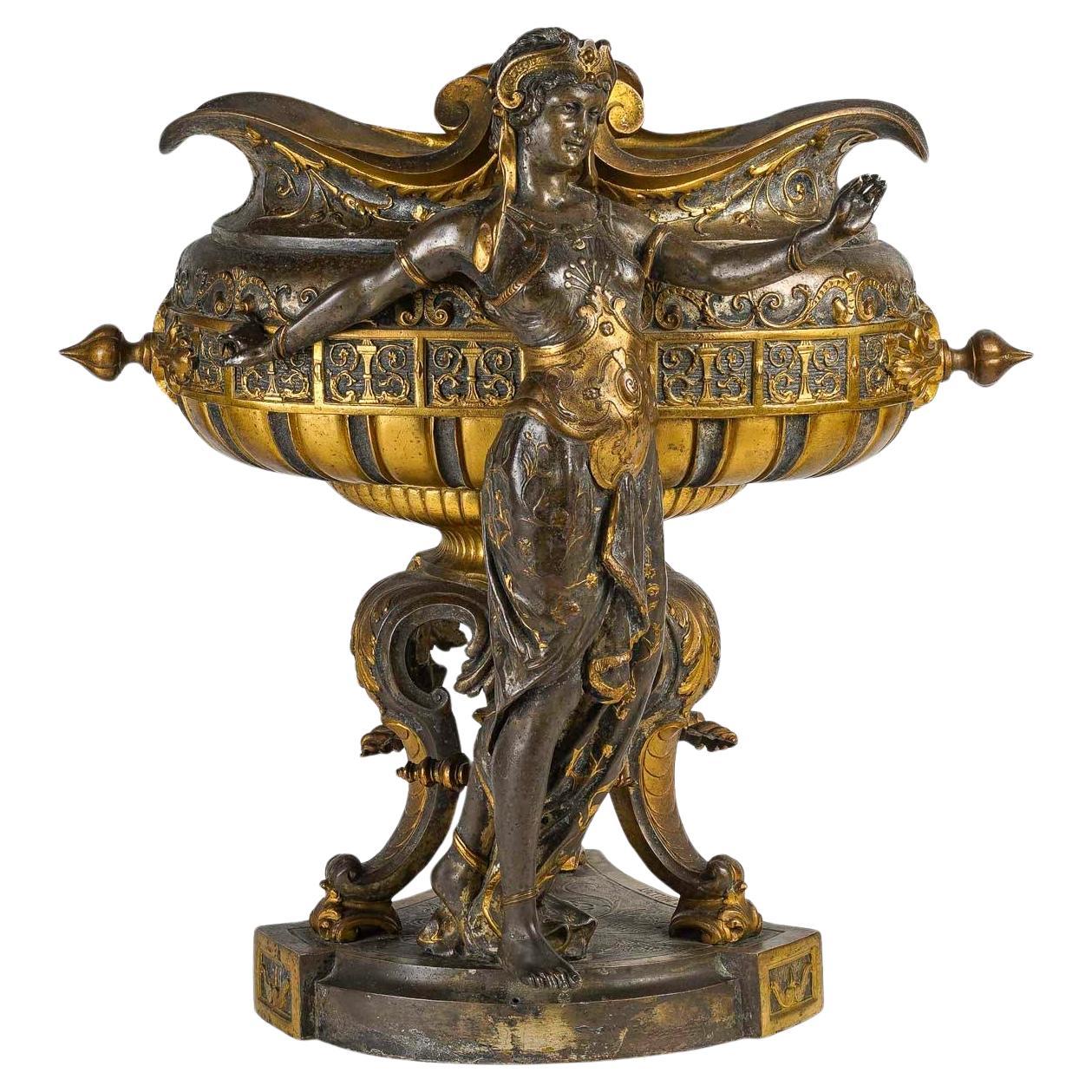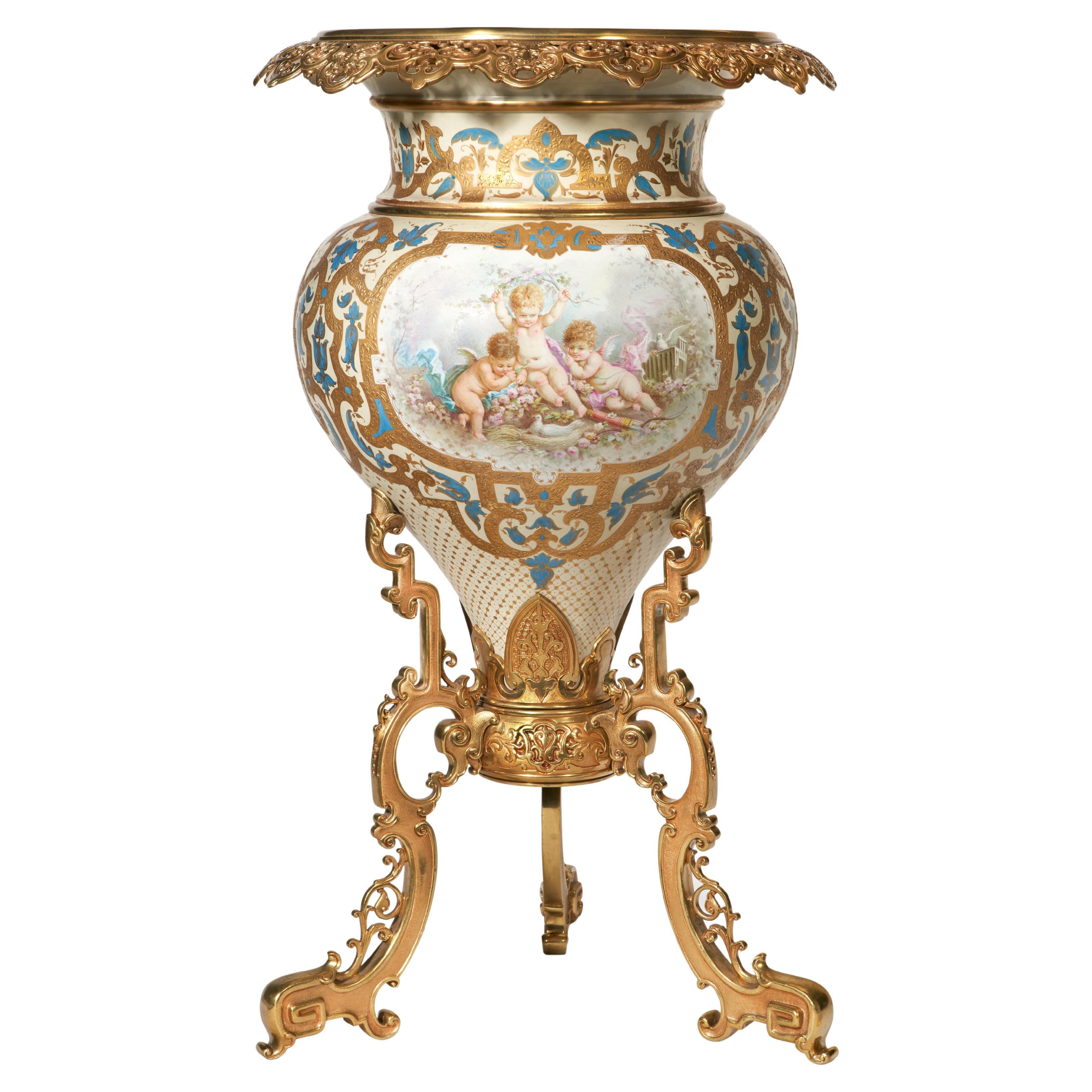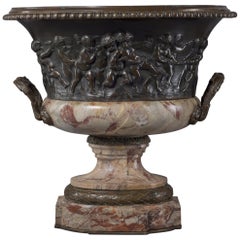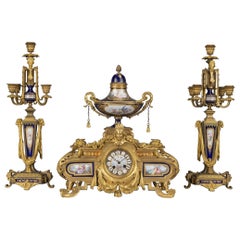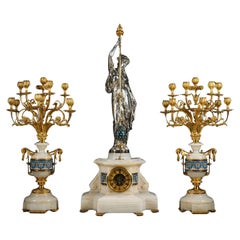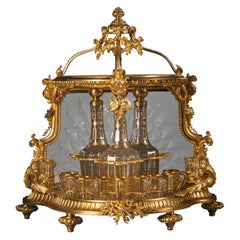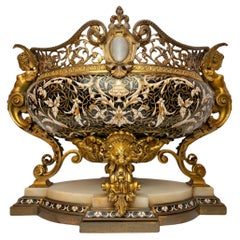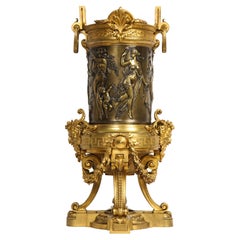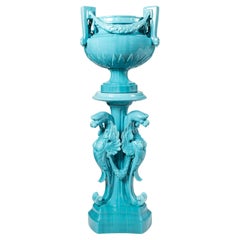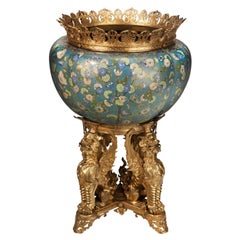Items Similar to Exhibition Champlevé Enamel Jardinière by Servant, Paris, circa 1870
Want more images or videos?
Request additional images or videos from the seller
1 of 15
Exhibition Champlevé Enamel Jardinière by Servant, Paris, circa 1870
$117,533.50
£85,000
€100,424.15
CA$162,235.61
A$180,261.49
CHF 94,756.33
MX$2,200,288.32
NOK 1,198,057.80
SEK 1,123,206
DKK 749,493.41
About the Item
An Exhibition Gilt-Bronze and Champlevé Enamel Jardinière, By George Servant, Paris.
This magnificent ‘Louis Seize’ jardinière is designed in the Néo-Grec style. The handles are superbly sculpted in gilt and chased bronze as classical maidens holding laurel garlands. Front ant back are modelled with characterful satyr masks. The champlevé enamel frieze of scrolling and fruiting vine is most finely wrought in polychrome colours. The basin is raised on hoofed legs joined by a belt cast with Greek key. The platform base with concave sides.
Singed 'G. SERVANT / MEDLLE D'OR 1867'.
France, Circa 1870.
Engraved to commemorate their success at the 1867 Paris Exhibition, this jardinière was actually shown by the bronzier Georges Servant at the 1878 Paris Exhibition where it is recorded in the Art Journal with an engraving and description “M. Servant, a renowned ébéniste of Paris, maintains the high rank he has long held amongst the foremost cabinet-makers of France […] we engrave on this page a Jardiniere, style Louis Seize, the central band being enamelled in tints” (The Art Journal, London, 1878, Vol. 17, p. 64).
This jardinière demonstrates the design flair and exquisite quality associated with the finest objets de luxe made during the Second Empire period. The bronze modelling, chasing and mercury gilding are exceptional. The champlevé enamel is drawn from Oriental work, but a technique perfected in Paris by Servant and his contemporaries Émile Reiber (1826-1893), at the silversmith Christofle, and Louis-Constant Sévin (1821-1888), at the Barbedienne foundry.
Exhibited: International Exhibition, Paris, 1878.
Literature: The Art Journal Illustrated Catalogue of the Paris Exhibition, London, 1878, Vol. 17, p. 64 (illustrated).
- Creator:Georges Emile Henri Servant (Maker)
- Dimensions:Height: 22.05 in (56 cm)Width: 22.84 in (58 cm)Depth: 14.97 in (38 cm)
- Style:Neoclassical (In the Style Of)
- Materials and Techniques:
- Place of Origin:
- Period:
- Date of Manufacture:Circa 1870
- Condition:Wear consistent with age and use.
- Seller Location:Brighton, GB
- Reference Number:Seller: B781911stDibs: LU1028044683162
About the Seller
5.0
Recognized Seller
These prestigious sellers are industry leaders and represent the highest echelon for item quality and design.
Established in 1964
1stDibs seller since 2014
58 sales on 1stDibs
Typical response time: 3 hours
Associations
The British Antique Dealers' AssociationLAPADA - The Association of Arts & Antiques Dealers
- ShippingRetrieving quote...Shipping from: Brighton, United Kingdom
- Return Policy
Authenticity Guarantee
In the unlikely event there’s an issue with an item’s authenticity, contact us within 1 year for a full refund. DetailsMoney-Back Guarantee
If your item is not as described, is damaged in transit, or does not arrive, contact us within 7 days for a full refund. Details24-Hour Cancellation
You have a 24-hour grace period in which to reconsider your purchase, with no questions asked.Vetted Professional Sellers
Our world-class sellers must adhere to strict standards for service and quality, maintaining the integrity of our listings.Price-Match Guarantee
If you find that a seller listed the same item for a lower price elsewhere, we’ll match it.Trusted Global Delivery
Our best-in-class carrier network provides specialized shipping options worldwide, including custom delivery.More From This Seller
View AllLouis XVI Style Patinated Bronze and Marble Jardinière after Clodion, circa 1870
By Claude Michel Clodion
Located in Brighton, West Sussex
A Louis XVI style patinated bronze and marble jardinière, cast in relief with Bacchanalian Scenes Of Putti at Play, After Clodion.
French, circa 1870.
The body of the jardiniè...
Category
Antique Late 19th Century French Louis XVI Planters and Jardinieres
Materials
Marble, Bronze
Napoleon III Clock Garniture Designed by Sévin, Cast by Barbedienne
By Louis-Constant Sevin, F. Barbedienne Foundry
Located in Brighton, West Sussex
A fine Napoleon III gilt-bronze and porcelain mounted clock garniture, designed by Louis-Constant Sévin, cast by Ferdinand Barbedienne, The Movement by Japy Frères.
Frédéric Japy ...
Category
Antique 19th Century French Napoleon III Mantel Clocks
Materials
Ormolu
A Napoleon III Gilt and Silvered Bronze, Onyx and Enamel Figural Clock Set
By Albert-Ernest Carrier-Belleuse
Located in Brighton, West Sussex
A Napoleon III Gilt and Silvered Bronze, Onyx and Champlevé Enamel Figural Three-Piece Clock Garniture. By Eugène Cornu for the Société des Marbres Onyx d'Algerie, the figure cast fr...
Category
Antique 19th Century French Napoleon III Mantel Clocks
Materials
Onyx, Bronze, Enamel, Ormolu
Napoleon III Decanter Set Attributed to Baccarat
By Cristalleries De Baccarat
Located in Brighton, West Sussex
A Gilt-Bronze and Cut-Glass Pagoda Form Cave à Liqueur, Attributed to Baccarat.
The shaped gilt bronze case finely cast with egg and dart moulding, acanthus fronds and musical tr...
Category
Antique 19th Century French Napoleon III Barware
Materials
Ormolu
Pair of Napoléon III Gilt-Bronze and Patinated Bronze Athéniennes
By Henri Picard
Located in Brighton, West Sussex
A Fine Pair of Napoléon III Gilt-Bronze and Patinated Bronze Athéniennes Modelled in the Classical Antique Style, Attributed to Henri Picard.
The bronze impressed with the number R...
Category
Antique 19th Century French Neoclassical Revival Planters, Cachepots and...
Materials
Bronze
Napoléon III Champlevé Enamel Centrepiece after Maison Giroux, circa 1870
By Maison Giroux
Located in Brighton, West Sussex
A Napoléon III gilt bronze and Champlevé enamel centrepiece, in the manner of Maison Alphonse Giroux.
French, circa 1870.
This exquisite centrepiece has a frosted glass trumpe...
Category
Antique Late 19th Century French Napoleon III Centerpieces
Materials
Enamel, Bronze
You May Also Like
Napoleon III Gilt-Bronze and Cloisonné Enamel Jardinière on White Onyx Base
Located in New York, NY
Napoleon III Gilt-Bronze and Cloisonné Enamel Jardinière on White Onyx Base
This oval form jardinière is wrapped with black, white and gold cloisonné enamel, with a shield at the ...
Category
Antique Late 19th Century Napoleon III Planters, Cachepots and Jardinières
Materials
Onyx, Bronze, Enamel
A 19th C. French Louis XVI Patinated & Doré Bronze Jardinière, F. Barbedienne
By Ferdinand Barbedienne
Located in New York, NY
A Magnificent and Large 19th Century French Louis XVI Style Patinated and Doré Bronze Jardinière/Planter, Attributed to F. Barbedienne The large and imposing piece features a regal ...
Category
Antique 19th Century French Louis XVI Planters, Cachepots and Jardinières
Materials
Bronze
Enamel Ceramic Planter, Attributed to Jerome Massier, France, Late 19th Century.
By Jerome Massier
Located in Buenos Aires, Buenos Aires
Enamel Ceramic Planter, Attributed to Jerome Massier, France, Late 19th Century.
Category
Antique Late 19th Century French Belle Époque Planters and Jardinieres
Materials
Ceramic
Ormolu and Cloisonné Enamel Jardinière Attributed to F. Barbedienne
By F. Barbedienne Foundry
Located in London, GB
The large central circular form cloisonne enamel jardinière decorated with vari colored plum flowers and butterflies on a blue ground, with a pierced ormolu rim featuring a pineapple motif resting on a finely cast ormolu base with four legs in the form of winged Foo lions.
The ormolu French, the enamel Chinese.
This impressive jardinie`re is very much in the manner of objects in enamel produced by Ferdinand Barbedienne in Paris in the last quarter of the 19th century which proved universally popular. Often these pieces were designed by Edouard Lievre (d. 1886) in the Oriental taste.
Ferdinand Barbedienne was a famous French metal worker and manufacturer. He presided over one of the most renowned and prolific foundries of Belle Époque Paris. His atelier created sculptures, clocks and bronze mounts of the highest quality, and his works were shown at numerous international exhibitions of the period, where he was rewarded with many medals. Among them the Grande Me´daille d'Honneur, in Paris in 1855 is particularly noteworthy.
In 1838 he associated with the engineer Achille Collas (1795-1859) who had just invented a process to reproduce statues at a smaller scale.
Together they founded in 1839 the company "Collas et Barbedienne" to reproduce casts of both contemporary artists and Greek and Roman antiquities. While working with Collas, Barbedienne actively pursued contracts with many sculptors of Paris contracting with David D'Angers, Jean-Baptiste Clesinger, and even producing some casts for Antoine Louis Barye as well as others. From 1860 to the years 1890, Barbedienne, eager to research new processes, experimented new techniques in champleve´ and cloisonne´-enamels, to compete with Japanese importations, very fashionable then.
When Collas died in 1859, the business was left to Barbedienne as sole owner. The company who had over 300 employees was prosperous as well in the field of reproductions as in its department specialized in the casting of monumental bronzes.
In 1865, he was appointed President of the Reunion of Bronze Makers until 1885.
After the 1870 war...
Category
Antique Late 19th Century French Chinoiserie Planters, Cachepots and Jar...
Materials
Enamel, Ormolu
Large Oriental Planter in Regula, Napoleon III Period.
Located in Saint-Ouen, FR
Large Oriental planter in Regula, Napoleon III period.
An important 19th century Napoleon III period Oriental jardinière in Regula.
h: 55cm, w: 60...
Category
Antique 19th Century French Napoleon III Planters, Cachepots and Jardini...
Materials
Bronze
Large & Important French 19th C. Sevres Porcelain Ormolu Mounted Jardiniere
By Manufacture Nationale de Sèvres
Located in New York, NY
A Large & Important French 19th C. Louis XVI Style Sevres Porcelain Ormolu Mounted Jardiniere. This magnificent piece is of a baluster form wi...
Category
Antique 1870s French Louis XVI Planters, Cachepots and Jardinières
Materials
Bronze
